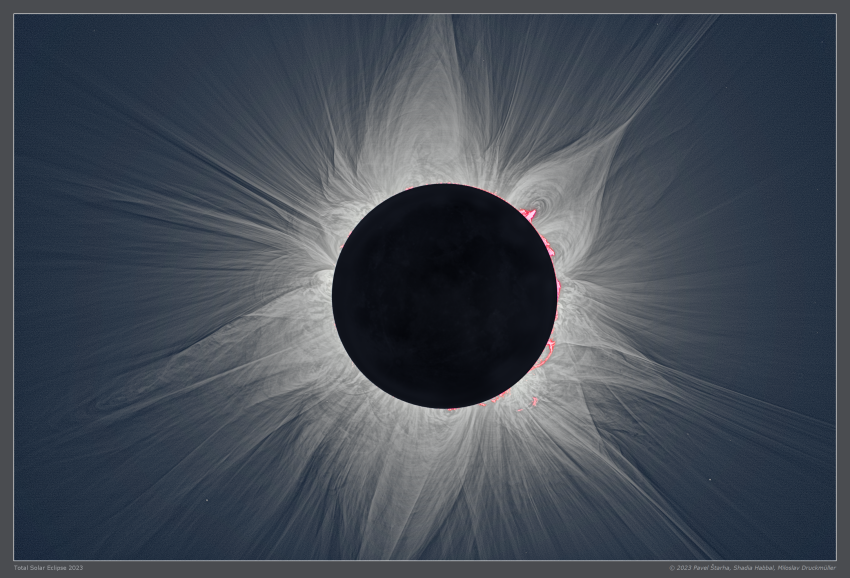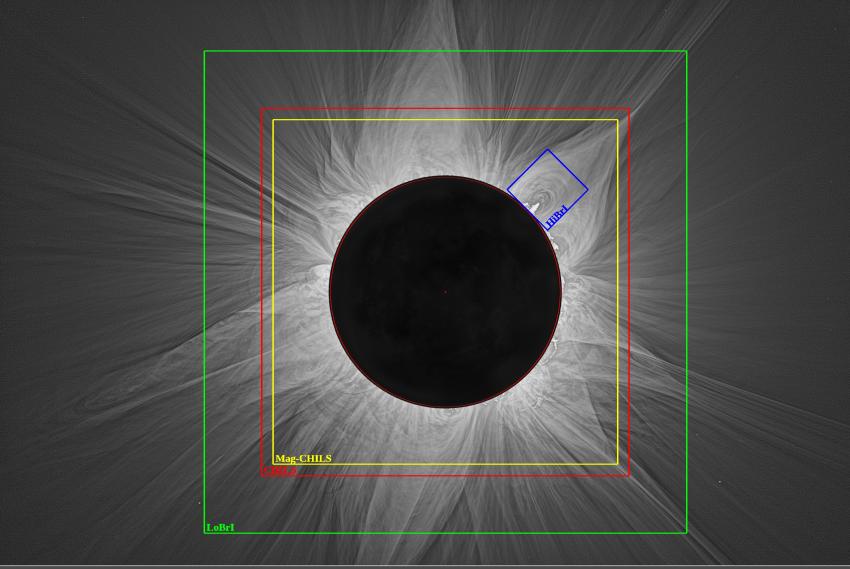Recreating artificial solar eclipses in space could help astronomers decipher the inner workings of our Sun much quicker than if they had to wait for the celestial show on Earth.
The plan, part of a UK-led space mission to be unveiled at the Royal Astronomical Society’s National Astronomy Meeting 2025 in Durham, would involve the use of a mini-satellite and the Moon's shadow to achieve the closest-ever views of the Sun's atmosphere.
The Moon-Enabled Sun Occultation Mission (MESOM) proposes a novel way to study the inner solar corona – the innermost layer of the Sun's atmosphere, which is usually only visible during fleeting total solar eclipses on Earth.
It is being presented by researchers from the Mullard Space Science Laboratory at University College London (UCL), Aberystwyth University, and the Surrey Space Centre, part of the University of Surrey.
If approved, MESOM could operate for two years and capture the equivalent of 80 Earth-based eclipses – an unprecedented opportunity for solar science which could also help researchers gain important clues about how space weather originates.
MESOM would place a small satellite into a special orbit that allows it to align with the Moon's shadow roughly once every 29.6 days – the length of a synodic (lunar) month.
These alignments would mimic the effects of total eclipses, but viewed in space, up to a maximum of 48 minutes – 10 times longer than typical eclipses seen from Earth. Unlike terrestrial observations, the satellite would capture data without interference from Earth's atmosphere.
Co-investigator Dr Nicola Baresi, from the Surrey Space Centre, said: "MESOM capitalises on the chaotic dynamics of the Sun-Earth-Moon system to reproduce total solar eclipse conditions in space while using the Moon as a natural occulter (something which blocks light from a celestial object)."
MESOM's goal is to explore the corona's innermost region, which holds key insights into space weather, solar storms and coronal heating, yet remains poorly understood, partly because it can only be studied under eclipse conditions.
Thanks to its innovative orbital configuration, MESOM would effectively experience a total solar eclipse every synodic month as it naturally passes through the apex of the Moon's umbral cone, or the darkest part of its shadow (every two of its revolutions).
This would allow it to see closer to the Sun than ever before. For comparison, the European Space Agency's (ESA) existing Proba-3 mission observes the corona out from approximately 1.1 solar radii (765,000 km), while MESOM's would reach below 1.02 solar radii (710,000 km), allowing it to get 56,000 km closer to the Sun.
MESOM would carry a suite of instruments, including a high-resolution coronal imager (a telescope to take high-res pictures) proposed to be led by the US Naval Research Laboratory; a corona mass spectrometer (Aberystwyth University and Mullard Space Science Laboratory UCL) to analyse the composition and properties of coronal plasma; and a spectropolarimeter (Spanish Space Solar Physics Consortium, S3PC, Spain) to study the Sun's magnetic field and solar phenomena, like sunspots and flares.
Dr Baresi said: "When the Sun is near the orbital plane of the Moon, we can experience total eclipses as long as 48 minutes, which would enable unprecedented and prolonged measurements of physical processes from which adverse space weather events, namely solar flares and coronal mass ejections, may originate."
The team submitted MESOM to ESA's F-class mission call in May 2025 and expects a response later this year. If selected, it could be launched between 2026-28.
F-class missions are designed to be smaller, faster, and more cost-effective than ESA's larger "M-class" missions, with a ceiling cost of €205 million (£175 million) and a development timeline of less than eight years from selection to launch.
ENDS
Media contacts
Sam Tonkin
Royal Astronomical Society
Mob: +44 (0)7802 877 700
Dr Robert Massey
Royal Astronomical Society
Mob: +44 (0)7802 877 699
Megan Eaves
Royal Astronomical Society
Science contacts
Dr Nicola Baresi
Surrey Space Centre
Dr Nicolò Bernardini
Surrey Space Centre
Images & video
Caption: Total solar eclipse as viewed from Earth in 2023.
Credit: Miloslav Druckmuller, Shadia Habbal, Pavel Starha
Caption: The same total solar eclipse with the fields of view of the MESOM instruments superimposed on top of it (i.e. HiBri,LoBri, CHILS and Mag-CHILS).
Credit: Miloslav Druckmuller, Shadia Habbal, Pavel Starha
Caption: The video is a simulation of how the Moon moves during MESOM observations.
Credit: Miloslav Druckmuller, Shadia Habbal, Pavel Starha
Further information
The talk 'Re-creating total solar eclipses in Space. The Moon-Enabled Sun Occultation Mission concept MESOM' will take place at NAM at 15:35 BST on Wednesday 9 July 2025 in room TLC101. Find out more at: https://conference.astro.dur.ac.uk/event/7/contributions/468/
● The MESOM concept is led by Mullard Space Science Laboratory UCL (UK) in collaboration with Aberystwyth University and the Surrey Space Centre, University of Surrey. International partners include the Naval Research Laboratory (USA) and the Spanish Space Solar Physics Consortium, S3PC, Spain.
● The concept builds on a feasibility study funded under the UK Space Agency's National Space Technology Programme and a recent UK Space Agency-funded bilateral study, which helped refine the science case and evaluate instrument options.
● The mission was submitted to the European Space Agency's F3 call in May 2025.
Notes for editors
The NAM 2025 conference is principally sponsored by the Royal Astronomical Society and Durham University.
About the Royal Astronomical Society
The Royal Astronomical Society (RAS), founded in 1820, encourages and promotes the study of astronomy, solar-system science, geophysics and closely related branches of science.
The RAS organises scientific meetings, publishes international research and review journals, recognises outstanding achievements by the award of medals and prizes, maintains an extensive library, supports education through grants and outreach activities and represents UK astronomy nationally and internationally. Its more than 4,000 members (Fellows), a third based overseas, include scientific researchers in universities, observatories and laboratories as well as historians of astronomy and others.
The RAS accepts papers for its journals based on the principle of peer review, in which fellow experts on the editorial boards accept the paper as worth considering. The Society issues press releases based on a similar principle, but the organisations and scientists concerned have overall responsibility for their content.
Keep up with the RAS on Instagram, Bluesky, LinkedIn, Facebook and YouTube.
Download the RAS Supermassive podcast
About the Science and Technology Facilities Council
The Science and Technology Facilities Council (STFC), part of UK Research and Innovation (UKRI), is the UK’s largest public funder of research into astronomy and astrophysics, particle and nuclear physics, and space science. We operate five national laboratories across the UK which, supported by a network of additional research facilities, increase our understanding of the world around us and develop innovative technologies in response to pressing scientific and societal issues. We also facilitate UK involvement in a number of international research activities including the ELT, CERN, the James Webb Space Telescope and the Square Kilometre Array Observatory.
About Durham University
Durham University is a globally outstanding centre of teaching and research based in historic Durham City in the UK.
We are a collegiate university committed to inspiring our people to do outstanding things at Durham and in the world.
We conduct research that improves lives globally and we are ranked as a world top 100 university with an international reputation in research and education (QS World University Rankings 2026).
We are a member of the Russell Group of leading research-intensive UK universities and we are consistently ranked as a top five university in national league tables (Times and Sunday Times Good University Guide and The Complete University Guide).
For more information about Durham University visit: www.durham.ac.uk/about/



